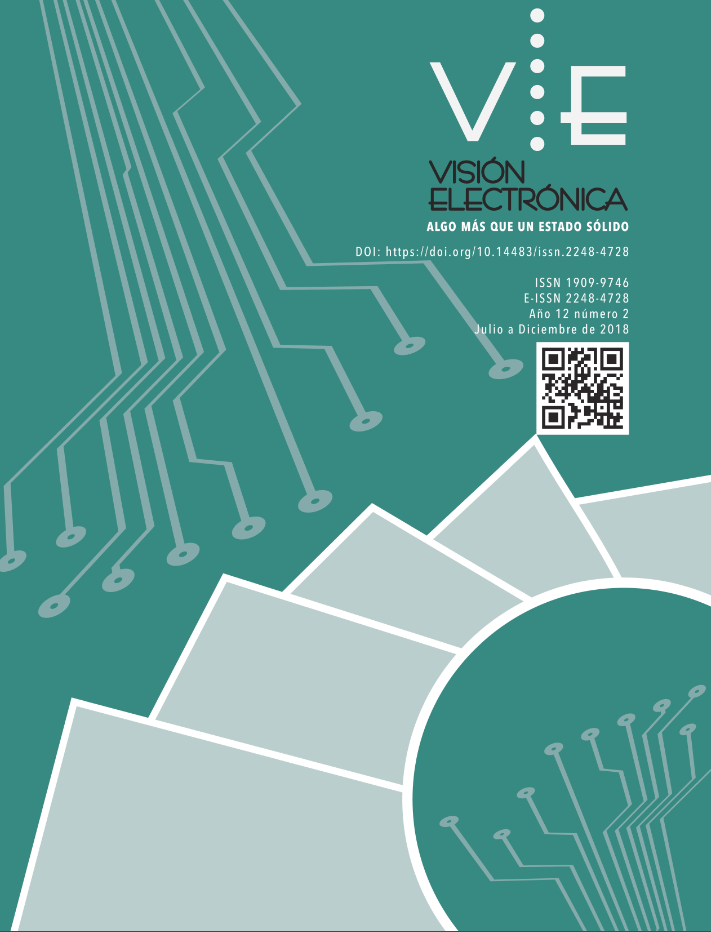DOI:
https://doi.org/10.14483/22484728.14263Publicado:
2018-12-12Número:
Vol. 12 Núm. 2 (2018)Sección:
Visión de CasoLaboratorios remotos: estudio de caso con una planta térmica didáctica
Remote laboratories: case study with a didactic thermal plant
Palabras clave:
control, instrumentation, IoT, remote laboratories, thermal plant, monitoring (en).Palabras clave:
control, instrumentación, IoT, laboratorios remotos, planta térmica, supervisión (es).Descargas
Resumen (es)
en este documento se presentan los resultados del proyecto de investigación cuyo objetivo fue analizar, diseñar, implementar y verificar un laboratorio remoto a partir de una planta térmica instalada en una sala de investigación de la Facultad Tecnológica de la Universidad Distrital Francisco José de Caldas. Por lo anterior, se obtiene un laboratorio implementable en programas de enseñanza de la ingeniería -o entrenamiento de personal calificado- para realizar prácticas de control, instrumentación, y automatización con plantas reales, en ausencia de recursos y personal suficientes. Se ilustra la superación de retos tecnológicos propios de un desarrollo hardware-software-web tales como: selección de las variables de la planta, acciones remotas, plataforma de hardware y software sujetas a requerimientos técnicos, disponibilidad del servidor web, interfaz amigable para usuarios remotos, así como estimación de tiempos de respuesta. Esta propuesta establece una metodología de aprovechamiento de los avances en tecnologías como IoT (Internet of Things), ofreciendo alternativas técnicas que valen la pena asumir en futuras implementaciones.
Resumen (en)
This paper presents the results of research project whose objective was to analyze, design, implement and verify a remote laboratory from a didactic thermal plant installed in the Technological Faculty of the Distrital Francisco José de Caldas University. During the execution of this project, several technical challenges of a hardware-software-web development were presented, such as: the selection of plant variables to be uploaded, which actions that could be performed remotely, what hardware and software platform would respond to the technical requirements, what is the availability of the web server, what is the best user-friendly interface to a remote user and how to have low response times. The justification of a remote laboratory can be seen in the need that is in engineering teaching programs -or training of qualified personnel- to practice control, instrumentation, automation with real plants when there is trouble with the availability of resources and staff. For this, it is proposed achieve this taking advantage of the advances in technologies like IoT (Internet of Things) and offer alternatives that are worth studying.
Referencias
P. Lorandi, G. Hermida, J. Hernánez, and E. Guevara, “Los Laboratorios Virtuales y Laboratorios Remotos en la Enseñanza de la Ingeniería,” Rev. Int. Educ. en Ing., vol. 4, pp. 24–30, 2011.
M. Tawfik et al., “Defining the Critical Factors in the Architectural Design of Remote Laboratories,” IEEE Rev. Iberoameriocana Tecnol. del Aprendiz., vol. 10, no. 4, pp. 269–279, 2015, https://doi.org/10.1109/RITA.2015.2486388
L. Rosado and J. R. Herreros, “Laboratorios virtuales y remotos en la enseñanza de la Física y materias afines,” Didáctica la Física y sus nuevas Tendencias, vol. 38, pp. 415–603, 2002.
S. Marchisio, F. Lerro, and O. Von Pamel, “Empleo de un laboratorio remoto para promover aprendizajes significativos en la enseñanza de los dispositivos electrónicos,” Pixel-Bit. Rev. Medios y Educ., n° 38, pp. 129–139, 2011.
S. Ray, Y. Jin, and A. Raychowdhury, “The Changing Computing Paradigm with Internet of Things: A Tutorial Introduction,” IEEE Des. Test, vol. 33, n° 2, pp. 76–96, 2016, https://doi.org/10.1109/MDAT.2016.2526612
K. Ashton, “That ‘internet of things’ thing,” RFiD J., vol. 22, n° 7, pp. 97–114, 2009.
S. W. Tho, Y. Y. Yeung, R. Wei, K. W. Chan, and W. W. So, “A Systematic Review of Remote Laboratory Work in Science Education with the Support of Visualizing its Structure through the HistCite and CiteSpace Software,” Int. J. Sci. Math. Educ., vol. 15, n° 7, pp. 1217–1236, 2017, https://doi.org/10.1007/s10763-016-9740-z
M. Tawfik et al., “Middleware solutions for service-oriented remote laboratories: A review,” in Global Engineering Education Conference (EDUCON), 2014 IEEE, 2014, pp. 74–82, https://doi.org/10.1109/EDUCON.2014.6826071
F. G. Loro, A. Macho, E. Sancristobal, M. R. Artacho, G. Díaz, and M. Castro, “Remote laboratories for electronics and new steps in learning process integration,” in Remote Engineering and Virtual Instrumentation (REV), 2016 13th International Conference on, 2016, pp. 112–117, https://doi.org/10.1109/REV.2016.7444449
A. Cassanelli, “Proyectos de I + D , aplicación de metodologías de gestión de proyectos,” III Congr. Iberoam. Ing. Proy., 2012.
H. C. Cuno, “Automatización y monitoreo de una planta para pasteurización de leche,” Tesis de pregrado, Universidad Nacional de San agustin de Arequipa, 2015.
M. Zubicaray, “Bombas: teoría, diseño y aplicaciones,” México: Limusa S. A, 2005.
E. J. A. Rodríguez, J. W. M. Ocampo, and C. A. S. Ortega, “Medición de temperatura: sensores termoeléctricos,” Sci. Tech., vol. 1, no. 34, 2007.
K. J. McNaughton, “Bombas: Selección, Uso y Mantenimiento,” Chem. Eng., vol. 621, n° 67, p. 379, 1989.
A. Chacón, “Plataforma Didáctica para el Estudio de Procesos Térmicos en Laboratorio de Instrumentación Industrial.,” Tesis de maestría, Pontificia Universidad Javeriana, 2013.
“Particle Datasheets Documentation | Photon datasheet.” [En linea] Disponible en: https://docs.particle.io/datasheets/photon-datasheet/
E. Guimaraes, E. Cardozo, and D. Moraes, “Design and implementation issues for modern remote laboratories,” IEEE Trans., vol. 4, no. 2, pp. 149–161, 2011, https://doi.org/10.1109/TLT.2010.22
J. García-Zubia and P. Orduna, “Addressing software impact in the design of remote laboratories,” IEEE Trans., vol. 56, no. 12, pp. 4757–4767, 2009, https://doi.org/10.1109/TIE.2009.2026368
M. Valls and P. Val, “Usage of DDS data-centric middleware for remote monitoring and control laboratories,” IEEE Trans. Ind. Informatics, vol. 9, n° 1, pp. 567–574, 2013, https://doi.org/10.1109/TII.2012.2211028


.png)




.jpg)





